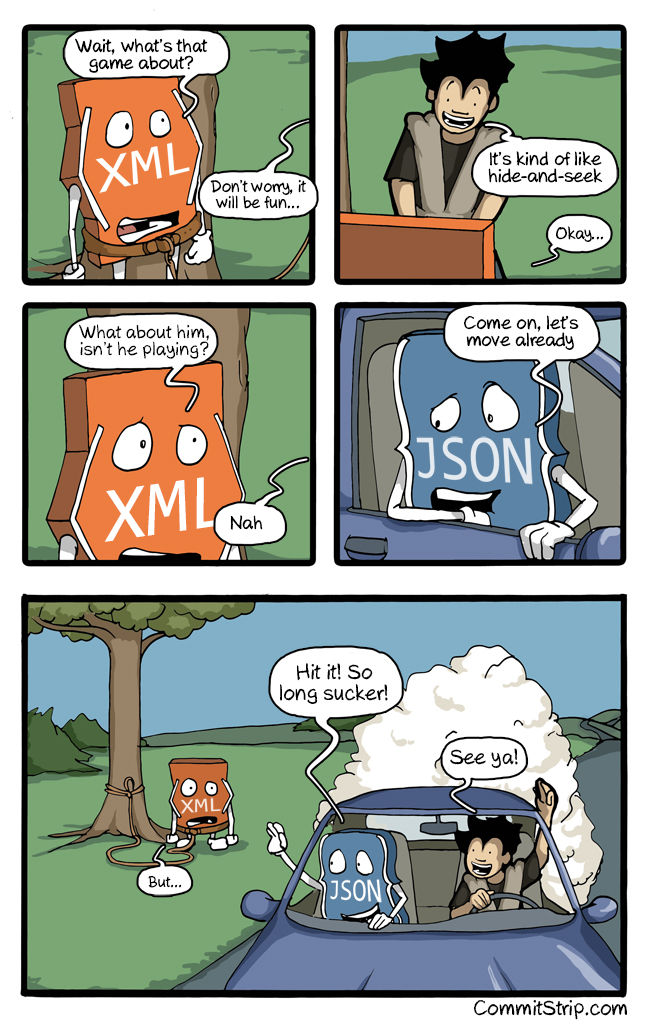A4 XML External Entities (XXE)
 Image from CommitStrip | And that’s how good old XML disappeared
Image from CommitStrip | And that’s how good old XML disappeared
Definition
Many older or poorly configured XML processors evaluate external entity references within XML documents. External entities can be used to disclose internal files using the file URI handler, internal file shares, internal port scanning, remote code execution, and denial of service attacks.
Risk Factor Summary
- Score: 7.0
- Attack Vectors Exploitability: 2
- Security Weakness Prevalence: 2
- Security Weakness Detectability: 3
- Impact Technical: 3
Context
Attackers can exploit vulnerable XML processors if they can upload XML or include hostile content in an XML document, exploiting vulnerable code, dependencies or integrations.
By default, many older XML processors allow specification of an external entity, a URI that is dereferenced and evaluated during XML processing.
SAST tools can discover this issue by inspecting dependencies and configuration. DAST tools require additional manual steps to detect and exploit this issue. Manual testers need to be trained in how to test for XXE, as it not commonly tested as of 2017.
These flaws can be used to extract data, execute a remote request from the server, scan internal systems, perform a denial-of-service attack, as well as execute other attacks.
The business impact depends on the protection needs of all affected application and data.
Is the Application Vulnerable?
Applications and in particular XML-based web services or downstream integrations might be vulnerable to attack if:
- The application accepts XML directly or XML uploads, especially from untrusted sources, or inserts untrusted data into XML documents, which is then parsed by an XML processor.
- Any of the XML processors in the application or SOAP based web services has document type definitions (DTDs) enabled. As the exact mechanism for disabling DTD processing varies by processor, it is good practice to consult a reference such as the OWASP Cheat Sheet 'XXE Prevention'.
- If your application uses SAML for identity processing within federated security or single sign on (SSO) purposes. SAML uses XML for identity assertions, and may be vulnerable.
- If the application uses SOAP prior to version 1.2, it is likely susceptible to XXE attacks if XML entities are being passed to the SOAP framework.
- Being vulnerable to XXE attacks likely means that the application is vulnerable to denial of service attacks including the Billion Laughs attack.
Conceptual Attacks
Numerous public XXE issues have been discovered, including attacking embedded devices. XXE occurs in a lot of unexpected places, including deeply nested dependencies. The easiest way is to upload a malicious XML file, if accepted:
Scenario #1:
The attacker attempts to extract data from the server:
<?xml version="1.0" encoding="ISO-8859-1"?>
<!DOCTYPE foo [
<!ELEMENT foo ANY >
<!ENTITY xxe SYSTEM "file:///etc/passwd" >]>
<foo>&xxe;</foo>
Scenario #2:
An attacker probes the server's private network by changing the above ENTITY line to:
<!ENTITY xxe SYSTEM "https://192.168.1.1/private" >]>
Scenario #3:
An attacker attempts a denial-of-service attack by including a potentially endless file:
<!ENTITY xxe SYSTEM "file:///dev/random" >]>
Scenario #4:
An attacker attempts a denial-of-service attack by expanding entities, like Billion laughs attack.
👉 Check XML Bomb attack in this Guide for more details
<?xml version="1.0"?>
<!DOCTYPE lolz [
<!ENTITY lol "lol">
<!ELEMENT lolz (#PCDATA)>
<!ENTITY lol1 "&lol;&lol;&lol;&lol;&lol;&lol;&lol;&lol;&lol;&lol;">
<!ENTITY lol2 "&lol1;&lol1;&lol1;&lol1;&lol1;&lol1;&lol1;&lol1;&lol1;&lol1;">
<!ENTITY lol3 "&lol2;&lol2;&lol2;&lol2;&lol2;&lol2;&lol2;&lol2;&lol2;&lol2;">
<!ENTITY lol4 "&lol3;&lol3;&lol3;&lol3;&lol3;&lol3;&lol3;&lol3;&lol3;&lol3;">
<!ENTITY lol5 "&lol4;&lol4;&lol4;&lol4;&lol4;&lol4;&lol4;&lol4;&lol4;&lol4;">
<!ENTITY lol6 "&lol5;&lol5;&lol5;&lol5;&lol5;&lol5;&lol5;&lol5;&lol5;&lol5;">
<!ENTITY lol7 "&lol6;&lol6;&lol6;&lol6;&lol6;&lol6;&lol6;&lol6;&lol6;&lol6;">
<!ENTITY lol8 "&lol7;&lol7;&lol7;&lol7;&lol7;&lol7;&lol7;&lol7;&lol7;&lol7;">
<!ENTITY lol9 "&lol8;&lol8;&lol8;&lol8;&lol8;&lol8;&lol8;&lol8;&lol8;&lol8;">
]>
<lolz>&lol9;</lolz>
How to Prevent
Developer training is essential to identify and mitigate XXE. Besides that, preventing XXE requires:
- Whenever possible, use less complex data formats such as JSON, and avoiding serialization of sensitive data.
- Patch or upgrade all XML processors and libraries in use by the application or on the underlying operating system. Use dependency checkers. Update SOAP to SOAP 1.2 or higher.
- Disable XML external entity and DTD processing in all XML parsers in the application, as per the OWASP Cheat Sheet 'XXE Prevention'.
- Implement positive ("whitelisting") server-side input validation, filtering, or sanitization to prevent hostile data within XML documents, headers, or nodes.
- Verify that XML or XSL file upload functionality validates incoming XML using XSD validation or similar.
- SAST tools can help detect XXE in source code, although manual code review is the best alternative in large, complex applications with many integrations. If these controls are not possible, consider using virtual patching, API security gateways, or Web Application Firewalls (WAFs) to detect, monitor, and block XXE attacks.